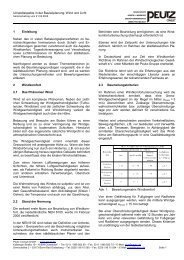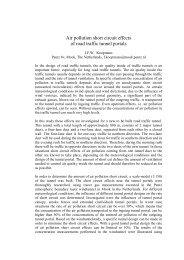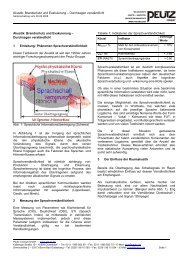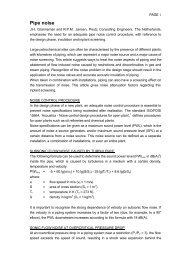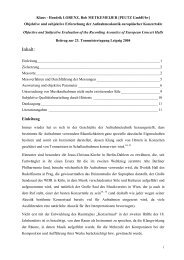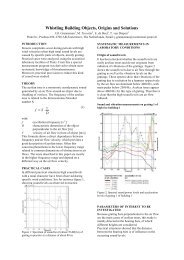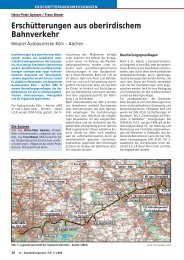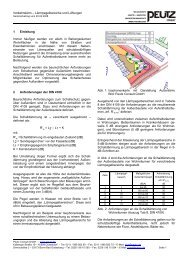The renovation of De Doelen Concert Hall Introduction - PEUTZ ...
The renovation of De Doelen Concert Hall Introduction - PEUTZ ...
The renovation of De Doelen Concert Hall Introduction - PEUTZ ...
You also want an ePaper? Increase the reach of your titles
YUMPU automatically turns print PDFs into web optimized ePapers that Google loves.
<strong>The</strong> <strong>renovation</strong> <strong>of</strong> <strong>De</strong> <strong>Doelen</strong> <strong>Concert</strong> <strong>Hall</strong><br />
M.Vercammen 1 , M. Lautenbach 2<br />
1 Peutz bv, Mook, <strong>The</strong> Netherlands, Email:m.vercammen@mook.peutz.nl<br />
2 Peutz bv, Zoetermeer, <strong>The</strong> Netherlands, Email:m.lautenbach@zoetermeer.peutz.nl<br />
<strong>Introduction</strong><br />
<strong>The</strong> main hall <strong>of</strong> <strong>De</strong> <strong>Doelen</strong>, Rotterdam, the Netherlands, is<br />
a concert hall for classical music with a volume <strong>of</strong> about<br />
27,000 m³ and a seating capacity <strong>of</strong> 2242. <strong>The</strong> <strong>Hall</strong> opened<br />
in 1966. <strong>The</strong> architect was B. Kraaijvanger and the<br />
acoustical consultants were Pr<strong>of</strong>. C.W. Kosten and P.A. de<br />
Lange. In 2009 the hall will be renovated. As a part <strong>of</strong> the<br />
<strong>renovation</strong> design, research has been done on the room<br />
acoustics. <strong>De</strong>spite the very good reputation <strong>of</strong> the main hall<br />
acoustics [1],[2], possible improvements are investigated<br />
within the scope <strong>of</strong> the <strong>renovation</strong>.<br />
An important part <strong>of</strong> the research had to do with the stage<br />
acoustics. When opened, the main concert hall in <strong>De</strong> <strong>Doelen</strong>,<br />
was fitted with six canopies above the stage platform [3],[4],<br />
see figure 1. <strong>The</strong>ir function was tw<strong>of</strong>old:<br />
- to provide a large part <strong>of</strong> the audience with early<br />
reflections;<br />
- to create good ensemble conditions for the musicians on<br />
stage.<br />
<strong>De</strong>spite good reviews after the opening, a few years later the<br />
canopies were removed, because they caused unwanted<br />
reflections at the recording microphone positions just below<br />
the canopy. Since then, a significant percentage <strong>of</strong> the<br />
orchestra is not completely satisfied with the acoustic<br />
conditions on stage. During the design process <strong>of</strong> the<br />
<strong>renovation</strong>, possibilities to re-introduce a stage canopy and<br />
influences <strong>of</strong> shape and materials are investigated.<br />
In this paper we will present an analysis <strong>of</strong> the existing hall,<br />
acoustic objectives for the <strong>renovation</strong> and the results <strong>of</strong> the<br />
investigations by means <strong>of</strong> scale model research, a ray<br />
tracing computer model and laboratory measurements.<br />
Figure 1: floor plan <strong>of</strong> the main hall <strong>De</strong> <strong>Doelen</strong>, 1966, with<br />
the positions <strong>of</strong> the 6 curved reflectors indicated<br />
Analysis <strong>of</strong> existing hall<br />
<strong>The</strong> hall is relative large, with a length <strong>of</strong> 60 m, max. height<br />
about 18 m and width ranging from 29 to 39 m. To keep the<br />
delay <strong>of</strong> the first reflection within 50 ms in the middle<br />
(parterre) area, inner walls were created. <strong>The</strong> parterre area is<br />
lowered, thus creating these inner walls.<br />
This ‚marble’ (actually it is travertine) wall with its sound<br />
diffusing blocks is very characteristic for <strong>De</strong> <strong>Doelen</strong> (fig.12).<br />
<strong>The</strong> general opinion on the acoustic <strong>of</strong> the <strong>De</strong> <strong>Doelen</strong> is that<br />
it is very good, especially transparent and clear.<br />
RT [s]<br />
RT [s]<br />
3,2<br />
3<br />
2,8<br />
2,6<br />
2,4<br />
2,2<br />
2<br />
1,8<br />
1,6<br />
1,4<br />
Figure 2: Reverberation times in <strong>De</strong> <strong>Doelen</strong> and other<br />
halls, unoccupied<br />
3,2<br />
3<br />
2,8<br />
2,6<br />
2,4<br />
2,2<br />
2<br />
1,8<br />
1,6<br />
1,4<br />
reverberation time in unoccupied hall<br />
1,2<br />
125 250 500 1k 2k 4k<br />
frequency [Hz]<br />
reverberation time in occupied hall<br />
1,2<br />
125 250 500 1k 2k 4k<br />
frequency [Hz]<br />
<strong>Doelen</strong> Rotterdam<br />
<strong>Concert</strong>gebouw<br />
Amsterdam<br />
Boston symphony hall<br />
Berlin philharmonie<br />
Berlin Konzerthaus<br />
Gewandhaus Leipzig<br />
Vienna Grosser<br />
musikvereinssaal<br />
<strong>Doelen</strong> Rotterdam<br />
<strong>Concert</strong>gebouw<br />
Amsterdam<br />
Boston symphony hall<br />
Berlin philharmonie<br />
Berlin Konzerthaus<br />
Gewandhaus Leipzig<br />
Vienna Grosser<br />
musikvereinssaal<br />
Figure 3: Reverberation times in <strong>De</strong> <strong>Doelen</strong> and other<br />
halls, occupied<br />
Measurements (figure 2,3) show that it does not lack<br />
reverberance. On the other hand, for a hall this big a<br />
somewhat longer RT would still be possible. At lower<br />
frequencies the RT drops. This was originally not intended.<br />
<strong>The</strong> large volume and large number <strong>of</strong> seats causes a relative<br />
low strength, especially at large distance from the stage (see<br />
figure 4).<br />
<strong>The</strong> clarity in the hall is –1,4 dB (1kHz, average in the<br />
audience area). This is relatively high for a concert hall. <strong>The</strong><br />
support at the front positions at stage is –17 dB, this is low.<br />
<strong>The</strong> marble blocks give some very high frequency<br />
reflections back to the stage area. <strong>The</strong>re used to be<br />
complaints about this, but by using stage risers these<br />
complaints have diminished.
strength G [dB]<br />
10,0<br />
8,0<br />
6,0<br />
4,0<br />
2,0<br />
0,0<br />
10 15 20 25<br />
Figure 4: Strength as a function <strong>of</strong> distance from the source<br />
in <strong>De</strong> <strong>Doelen</strong> and some other halls<br />
Acoustic objectives for the <strong>renovation</strong><br />
<strong>The</strong> basic characteristics <strong>of</strong> the hall, such as the volume,<br />
shape floor slope etc could not be changed. Also the<br />
finishing <strong>of</strong> the marble and wooden walls had to be<br />
maintained due to the monumental status. <strong>The</strong> degrees <strong>of</strong><br />
freedom were confined to the floor covering, the seats and<br />
the ceiling (shape and material).<br />
<strong>The</strong> reverberation time aimed at is the existing RT for the<br />
high frequencies +0.1 s. For the lower frequencies it should<br />
be frequency independent (around 2,3 s. occupied).<br />
Especially in the rear area the G should be increased by 1 dB<br />
or more.<br />
<strong>The</strong> playing conditions for the musicians should be<br />
improved, bringing back the functionality <strong>of</strong> the original<br />
stage reflectors (see next chapter).<br />
number <strong>of</strong> musicians<br />
number <strong>of</strong> musicians<br />
25<br />
20<br />
15<br />
10<br />
5<br />
0<br />
25<br />
20<br />
15<br />
10<br />
5<br />
0<br />
scarcely (too)<br />
quiet<br />
4. How loud do you hear back the violins?<br />
on the<br />
quiete<br />
side<br />
good on the<br />
loud<br />
side<br />
(very)<br />
loud<br />
much<br />
too loud<br />
4. How loud do you hear back the brass section?<br />
scarcely (too)<br />
quiet<br />
distance from source [m]<br />
on the<br />
quiete<br />
side<br />
good on the<br />
loud<br />
side<br />
(very)<br />
loud<br />
much<br />
too loud<br />
DOELEN<br />
Konzerthaus<br />
Berlin(1)<br />
Konzerthaus<br />
Berlin(2)<br />
Gewandhaus<br />
Leipzig(1)<br />
Gewandhaus<br />
Leipzig(2)<br />
total<br />
violins<br />
violas<br />
celli<br />
double bass<br />
wood<br />
brass<br />
percussion<br />
total<br />
violins<br />
violas<br />
celli<br />
double bass<br />
wood<br />
brass<br />
percussion<br />
Figure 5: Some results <strong>of</strong> the questionnaire on the stage<br />
acoustics in <strong>De</strong> <strong>Doelen</strong>, among the musicians <strong>of</strong> the<br />
Rotterdam Philharmonic Orchestra<br />
Subjective research<br />
In order to obtain a good overview <strong>of</strong> the opinions<br />
concerning the stage acoustics, the musicians <strong>of</strong> the<br />
Rotterdam Philharmonic Orchestra were asked to fill out<br />
questionnaires. <strong>The</strong>y were asked to give their opinion on<br />
their own playing conditions, the ensemble conditions, the<br />
stage and hall acoustics in general. <strong>The</strong> questionnaires were<br />
also taken in the Singel in Antwerpen. Two examples <strong>of</strong> the<br />
results from the questionnaire are given in figure 5.<br />
From the questionnaires the most important conclusion on<br />
loudness and intelligibility is that the musicians <strong>of</strong> the<br />
Rotterdam Philharmonic Orchestra judge that <strong>De</strong> <strong>Doelen</strong><br />
Main hall has:<br />
- low loudness en intelligibility at the front positions <strong>of</strong> the<br />
stage, especially for the strings;<br />
- high loudness from the rear position <strong>of</strong> brass and<br />
percussion to the other instrument groups.<br />
<strong>The</strong> timbre in <strong>De</strong> <strong>Doelen</strong> <strong>of</strong> the loud and high-frequencyinstruments<br />
(brass and violins) is judged as rather shrill, the<br />
low-frequency instruments are judged as rather dead/woolly.<br />
Improvements <strong>of</strong> the acoustic <strong>of</strong> <strong>De</strong> <strong>Doelen</strong> stage will be<br />
focussed on an increase <strong>of</strong> loudness and intelligibility <strong>of</strong> the<br />
strings and to reduce the shrill character <strong>of</strong> the hall and make<br />
it sound warmer.<br />
In addition to the questionnaires, measurements were made<br />
on stage, from several source positions to the middle <strong>of</strong> all<br />
instrument groups. <strong>The</strong>se measurements were then<br />
correlated to the questionnaire results. Many <strong>of</strong> the energy<br />
parameters did not correlate to the subjective results. Only<br />
the ST1 (support) correlated to the result <strong>of</strong> the question on<br />
how loud the musician heard his own instrument back (see<br />
figure 6).<br />
Score<br />
3,00<br />
2,00<br />
1,00<br />
0,00<br />
-1,00<br />
-2,00<br />
To what extend is your own instrument intelligible /<br />
defined?<br />
-3,00<br />
scarcely<br />
-20,0 -18,0 -16,0 -14,0 -12,0 -10,0<br />
ST1 in dB<br />
entirely<br />
seperate<br />
excessive<br />
more than<br />
sufficient<br />
violins<br />
violas<br />
cello<br />
double bass<br />
wood<br />
brass<br />
percussion<br />
Figure 6: Relation between ST1 and musicians’ own<br />
playing conditions<br />
To describe the influence <strong>of</strong> the stage surroundings on<br />
intelligibility, only the early reflections are important (with<br />
no echoes or flutters present). <strong>The</strong>refore the “strength”<br />
parameter G is used, but with a time window from 5 to 80<br />
ms after direct sound, which excludes direct sound and takes<br />
into account reflections from surfaces up to a distance <strong>of</strong><br />
good<br />
moderate<br />
side<br />
insufficient
oughly 14 m (from middle stage), which is <strong>of</strong> course<br />
arbitrary. It is referred to as Early Reflections Strength, G5-80<br />
in dB:<br />
[m²]<br />
Although, for a certain value <strong>of</strong> Early Reflections Strength,<br />
the judgement differs for different instrument groups, within<br />
an instrument group there seems a consistent result. When<br />
asked “how loud do you hear a particular instrument group”,<br />
a higher value relates quite well to a higher G5-80, see figure<br />
7. Increasing the G5-80 on stage was one <strong>of</strong> the objectives for<br />
the <strong>renovation</strong>.<br />
Score<br />
3,00<br />
2,00<br />
1,00<br />
0,00<br />
-1,00<br />
-2,00<br />
80<br />
2<br />
p ( t) dt<br />
G 10log [ dB]<br />
p ( t) dt<br />
=<br />
5<br />
5− 80 2<br />
10<br />
Figure 7: Comparison <strong>of</strong> G 5-80 to the musician’s opinion<br />
regarding the loudness <strong>of</strong> other instruments<br />
Scale model research<br />
∫<br />
∫<br />
How loud do you hear the following instruments?<br />
-3,00<br />
scarcely<br />
-5,0 0,0 5,0 10,0<br />
G5-80 in dB<br />
much too<br />
loud<br />
(too) loud<br />
on the loud<br />
side<br />
Figure 8: Picture <strong>of</strong> the 1:10 scale model <strong>of</strong> <strong>De</strong> <strong>Doelen</strong><br />
with the new suspended technical ceiling above stage. In<br />
this ceiling the reflectors and lighting is integrated.<br />
<strong>The</strong> scale model is made scale 1:10. <strong>The</strong> material is mainly<br />
mdf, painted to reduce high frequency absorption. <strong>The</strong><br />
ceiling is made <strong>of</strong> 2 mm hard Polystyrene. <strong>The</strong> audience is<br />
made from foam material and placed on wooden strips. <strong>The</strong><br />
measurements are done with special high frequency<br />
omnidirectional sources and 1/8“ microphones to be able to<br />
good<br />
on the quiet<br />
side<br />
(too) quiet<br />
(1)<br />
<strong>De</strong> <strong>Doelen</strong> -<br />
violins<br />
<strong>De</strong> <strong>Doelen</strong> -<br />
cellos<br />
<strong>De</strong> <strong>Doelen</strong> -<br />
brass<br />
<strong>De</strong> Singel -<br />
violins<br />
<strong>De</strong> Singel -<br />
cellos<br />
<strong>De</strong> Singel -<br />
brass<br />
perform measurements up to 50 kHz. With a 1:10 scale<br />
model this enables measurements up to 5 kHz in reality.<br />
A stage reflector is proposed to improve the support at the<br />
front <strong>of</strong> the stage and the ensemble conditions. <strong>The</strong> stage<br />
reflector is positioned at a height <strong>of</strong> 10.5 m above the front<br />
<strong>of</strong> the stage and has slightly curved panels for diffusive<br />
reflections back to the stage.<br />
Figure 8 gives a picture <strong>of</strong> the scale model with the reflector.<br />
<strong>The</strong> flat edges will be made acoustically transparent. <strong>The</strong><br />
theatre lighting will be integrated in this suspended technical<br />
ceiling. Several configurations <strong>of</strong> the reflecting panels were<br />
tested, mainly to limit the influence <strong>of</strong> the reflector in the<br />
audience area.<br />
Figure 9: Measured impulsresponse (smoothed ETC)<br />
across stage (blue dot = source, red dot = mic). Existing<br />
situation (red line) and with new suspended ceiling (blue<br />
line)<br />
Figure 9 shows the effect <strong>of</strong> the final version. <strong>The</strong> reflector<br />
fills the gap between direct sound and early reflections.<br />
Figure 10 shows the effect <strong>of</strong> the reflector on the G5-80. This<br />
is compared to the situation without reflector and the<br />
reflectors <strong>of</strong> 1966. It shows that the new reflectors are very<br />
effective for Early Reflected Energy.<br />
G5-80 [dB]<br />
10,0<br />
5,0<br />
0,0<br />
Scale model measurements G5-80<br />
-5,0<br />
4,0 6,0 8,0 10,0 12,0<br />
Distance source - microphone<br />
Figure 10: Measured G 5-80 in the scale model with different<br />
settings <strong>of</strong> the stage reflector<br />
Without canopy<br />
Canopy 1966<br />
Canopy 2008<br />
Figure 10 also shows that there is no systematic dependency<br />
<strong>of</strong> the G5-80 to the distance from the source. Almost all other<br />
parameters have that.<br />
With the scale model many other alterations (partly<br />
incorporated in the design, partly not) are tested. On <strong>of</strong> the<br />
more important alterations is the reduce <strong>of</strong> the volume in the<br />
rear <strong>of</strong> the hall. Under the overhang the rear wall is moved to
the front, at the expense <strong>of</strong> 3 rows <strong>of</strong> seats with a reduced<br />
acoustical quality since these were outside the acoustic<br />
volume. <strong>The</strong> scale model showed an increase <strong>of</strong> the strength<br />
in the rear <strong>of</strong> the hall due to this new rear wall.<br />
Figure 11: Calculation model with stage reflector<br />
Computer model<br />
Most important objective <strong>of</strong> the computer model<br />
investigation (see figure 11) was to determine the impact <strong>of</strong><br />
the stage reflector on the reverberation time <strong>of</strong> the hall. With<br />
the proposed reflector the impact on the RT due to the<br />
reflector is minus 0.1 s, which will be compensated by other<br />
means (reduction <strong>of</strong> absorption <strong>of</strong> walls, ceiling, chairs). Just<br />
like in the scale model, the computer model calculations<br />
show that adding the stage reflector fills the gap between<br />
early reflections from the enclosure and the relative late<br />
reflections from the existing ceiling, resulting in an increase<br />
in ST1 and G5-80 <strong>of</strong> about 1 dB.<br />
Laboratory measurements<br />
In the Peutz Acoustic Laboratory measurements are<br />
performed <strong>of</strong> the absorption <strong>of</strong> ceiling, wall elements and the<br />
existing chairs. Based on these measurements requirements<br />
are set on materials and absorption <strong>of</strong> chairs. <strong>The</strong> ceiling will<br />
be <strong>of</strong> 30 mm gypsum fibre panel, total weight 35 kg/m 2 . Part<br />
<strong>of</strong> the wall panels will be altered, on the backside <strong>of</strong> these<br />
panels gypsum fibre panel will be added. <strong>The</strong> absorption <strong>of</strong><br />
the chairs will be reduced, mainly by reducing the thickness<br />
and the size <strong>of</strong> the foam.<br />
Conclusions<br />
<strong>The</strong> main acoustic objectives for the <strong>renovation</strong> <strong>of</strong> <strong>De</strong><br />
<strong>Doelen</strong> concert hall are the improvement <strong>of</strong> stage acoustics,<br />
increase <strong>of</strong> strength in the rear <strong>of</strong> the hall and increase in<br />
(low) frequency reverberation.<br />
Scale model, computer model and laboratory research has<br />
been done to define the means to provide these<br />
improvements. <strong>The</strong> most important change will be the<br />
introduction <strong>of</strong> a suspended technical ceiling above the<br />
stage, providing early reflections to the musicians. <strong>The</strong> rear<br />
<strong>of</strong> the hall will be moved in, 3 rows <strong>of</strong> seats will be<br />
removed. By increasing the surface weight <strong>of</strong> the ceiling and<br />
parts <strong>of</strong> the walls and by lowering the absorption is the<br />
chairs the reverberation time will be slightly increased.<br />
<strong>The</strong> <strong>renovation</strong> will be ready in September 2009.<br />
References<br />
[1] M. Barron, Auditorium Acoustics and Architectural<br />
<strong>De</strong>sign, 1993<br />
[2] L. Beranek, <strong>Concert</strong> halls and opera houses, Springer,<br />
2004<br />
[3] C.W. Kosten, <strong>De</strong> Nagalmtijden van <strong>De</strong> <strong>Doelen</strong>zalen te<br />
Rotterdam, NAG publicatie nr. 9 (1967, in Dutch)<br />
[4] P.A. de Lange, Aspecten van het akoestisch advies,<br />
NAG publicatie nr. 9 (1967, in Dutch).<br />
[5] A.C. Gade, Investigations <strong>of</strong> Musicians’ Room Acoustic<br />
Conditions in <strong>Concert</strong> <strong>Hall</strong>s. Part I and part II. Acustica<br />
volume 69 (1989).<br />
[6] K.-H. Lorenz-Kierakiewitz, M. Vercammen,<br />
Podienakustik und Sprachverständlichkeit in<br />
Konzertsälen, DAGA (2008 in German).<br />
[7] K.H. Lorenz, R.A. Metkemeijer, S. Mercier, Objektive<br />
Erforschung der Podiumsakustik Europäischer<br />
Konzertsäle, DAGA (2005 in German).<br />
[8] M. Lautenbach, M. Vercammen, K.-H. Lorenz-<br />
Kierakiewitz, Renovation <strong>of</strong> the concert <strong>Hall</strong> <strong>De</strong><br />
<strong>Doelen</strong>, Rotterdam, <strong>The</strong> Netherlands. Early reflections<br />
Strength and Stage Acoustics, Proc IOA, Oslo, 2008.<br />
Figure 12: Picture <strong>of</strong> <strong>De</strong> <strong>Doelen</strong>



